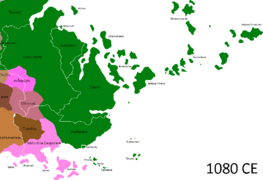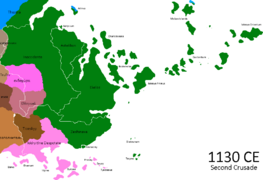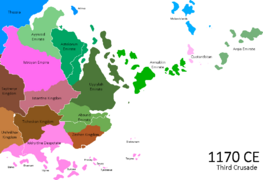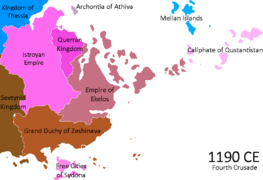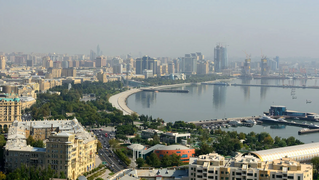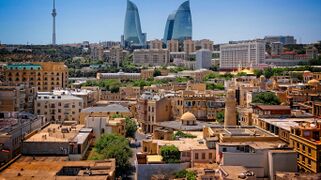Talk:Zeshinava
This article is a work-in-progress because it is incomplete and pending further input from an author. Note: The contents of this article are not considered canonical and may be inaccurate. Please comment on this article's talk page to share your input, comments and questions. |
The Neoteric Confederacy of Zeshinava Taz Nөvruvihn Sѧjioh-Tihnansyihӈ zat Zeжcihnωva (Zeshen) | |
|---|---|
|
Flag | |
Motto: Aжt dihmarz muvs yihnɛr өtuer ihnem! To love one's home above all! | |
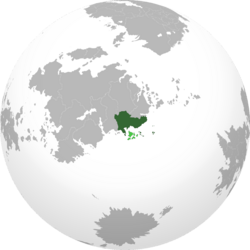 | |
| Location | Zeshinava in the Istroya region of southeastern Sarpedon |
| Capital and largest city | Kronzciny (Xronzsεnyy) |
| Official languages | Julian Ænglish, Zeshen |
| Recognised national languages | Istroyan, Zeshen |
| Minority languages | Latin |
| Demonym(s) | Zeshen (noun) Zeshen (adjective) |
| Government | Semi-Constitutional Parliamentary Unitary Republic overseen by an unelected Executive |
• Executive | Amelia Al-Ahzmira |
• Chancellor | Vaeran Khiaseak |
• Vice Chancellor | Violett Venihravihc |
| Legislature | Parliament |
| House of the Advisory & House of the Administration | |
| House of the Constituency | |
| Establishment | |
• Istroyan civilization established in Zeshinava | 800 BCE |
• Iddyritine Despotate conquered by Oduniyyad Caliphate | 900 CE |
• Zeshen Kingdom founded by crusaders | 1154 CE |
• Grand Duchy of Zeshinava founded | 1188 CE |
| Area | |
• Total | 1,184,531 km2 (457,350 sq mi) |
| Population | |
• Estimate | 85,476,530 |
• Census | 85,450,000 |
• Density | 72.2/km2 (187.0/sq mi) |
| GDP (nominal) | estimate |
• Total | $1,901,083,512,000 |
• Per capita | $22,241 |
| Currency | Zihase Ⱐ (ZSH) |
| Date format | dd/mm/yyyy CE |
| Mains electricity | 120 V 60 Hz |
| Driving side | right |
| Calling code | +138 |
| ISO 3166 code' | ZS |
| Internet TLD | .zs |
Zeshinava, officially the Neoteric Confederacy of Zeshinava, is a country in the Istroya region of southeastern Sarpedon. It is neighbored by the Sydona Islands and the Founders Sea.
Zeshinava is a storied country inhabited by the indigenous Sarpedonic people, who lived alongside the northern Istroyans for centuries prior to the arrival of the Oduniyyad Caliphate and its successor, the Iddyritine Emirates. The Zeshen and Iddyritine people assimilated with the establishment of the Zeshen Kingdom by the crusaders as the Oduniyyad Caliphate fell, though this saw resistance from the former exclusive High Sarpedonic ruling class. The falling Islamic powers took advantage of the squabbling peoples, leaving several independent emirates to take the lands of the Zeshens and Caliphate. The Fourth Crusade brought an end to the infighting, with the Zeshen Kingdom establishing itself in the northwest of present-day Zeshinava, the christening of the Absurian Empire along the south, and several other minor crusader states surviving in the east.
Zeshinava is abundant in natural resources like lithium, copper, nickel, zinc, coal, alongside significant deposits of iron, diamond, and especially natural gases in the southernmost reaches of the country. Historically, Zeshinava had a substantial agriculture industry in the northernmost and more hospitable regions of the country. The industrialization of Zeshinava was largely brought during the rule of the United Southern Working Class, transforming the economy by the dawn of the 20th century. It was a focus of the USWC regime to industrialize Zeshinava to a level equal to that of its continental counterparts. After this point, Zeshinava primarily refined coal and natural gas, produced commodity chemicals, electrical equipment, and a small electronics industry by the end of the Second Great War. While the manufacturing industry is still large to this day, Zeshinava is now dominated by its retail, banking, and medical industries. Recently education in Zeshinava has become a fast growing sector of the economy, largely due to efforts from the central government to improve access to education across the country and to international students.
Zeshinava is a member of the League of Nations.
Name and Etymology

The name Zeshinava translates literally to "Lady Ava". The country bears her name as she founded the crusader state of the Zeshen Kingdom, Queen of the Zeshen Kingdom, and later the Grand Duchess of Zeshinava. "Zeshinava" and "Zeshen" are often used by historians as shorthand to refer to the people and cultural continuum of southeastern Sarpedon prior to Ava's establishment of the Zeshen Kingdom, although this should be understood only to be a historiographical convention and functional exonym; no name for these people collectively existed.
History
Prehistory (Antiquity - 2000 BCE)
Paleolithic
Human activity in Zeshinava is traced back millions of years, alongside the activity found in neighboring eastern Sarpedon. Prior to habitation by modern humans, Kikpari inhabited much of the ZESHREGIONGEO and parts of the ZESHREGIONGEO. While not significantly settling the region, the Kikpari travelled across the land frequently, as seen in the wide distribution of stone tools, and later, fossilized bone. Homo sapiens migrated to Zeshinava later, with remains from humans being dated as far back as approximately 200,000 years ago. There is no evidence suggesting cohabitation took place between the Kikpari and homo sapiens, with items of Eastern Kikpari culture not existing past 200,000 BCE, barring limited evidence surfaced in Ventotene.
Neolithic
The Neolithic age is defined development of agricultural societies along the various rivers of Zeshinava and the surrounding region. The ZESHHIS Civilization traces its history back the furthest, with rice cultivation dating back to 10,000 BCE, though other agricultural societies existed on the ZESHREGIONGEO, ZESHREGIONGEO, ZESHREGIONGEO, and ZESHREGIONGEO rivers, with various different crops of choice. In addition to wheat, the staple crop of the rest of the Neolithic Occident, blackberry and pomegranate are also present in the archaeological record. The different agricultural societies formed different cultures, with the differing landscapes creating three distinct societies into the late Neolithic Era. The ZESHHIS culture, ZESHHIS Culture, and ZESHHIS Culture. Each of these cultures grew comfortable in their harvests and began burgeoning civilizations with room for more specialization. While southern Zeshinava attained agricultural know-how, the north of the country remained dominated by hunter societies into the early Bronze Age. These hunter societies remained numerous, and more closely resembled tribes than settlements, and relied on domesticating animals of the ZESHREGIONGEO rather than settling in one place. Horses, cows, and goats were domesticated some time around 3000 BCE, and would travel alongside tribes or be tamed as needed. Evidence of conflict between the agricultural societies and hunting tribes is limited, but conflict documented by later scholars and following famine suggests technological innovation brought about such.
Era of Survival (~2000 BCE - 600 BCE)
While the Era of Legend survives through folklore, the Era of Survival was chronicled by the first written languages of southern Sarpedon, most notably a philosopher only known as Dobr. His documentation is one of few substantive sources remaining that thoroughly chronicles the foundation of pre-Caliphate Zeshinavan society, though not without its limitations. The main text in which his documentation resides is known as the Pandect. The text documents various historical happenings along with stories of Dobr's travels throughout southern Sarpedon as he collected the region's history and the morals he formed throughout his journey. Other available texts are used to fill in gaps in time and writing of legend, but the library of pre-Caliphal literature remains limited into modern times.
Warlord Period (~2000 BCE)
Though shrouded in a thick fog of legend, all texts documenting early Duōma history talk of various skilled warlords leading fragmented territories across the ZESHREGIONGEO. Fighting was seemingly bitter and fierce, with different warlords training armies of soldiers in burgeoning combat practices. Resources across the plateau were minimal, leading to a scarce supply of adequate weaponry for battle. The power commanded by the warlords brought about tales of heroic combat between these powerful men, but Dobr paints a picture of a more grim reality on the war-torn steppe. He writes of vast empty lands controlled by small cavalry units while the citizenry was regularly short on necessities.
Though Dobr posits the existence of an organized and advanced civilization, there is no evidence outside of the Pandect to suggest such. The Pandect itself, while broadly reliable, seemingly both chronicles ancient Zeshinava and outlines its components. The ZESHHIS civilization existed outside of the scope of Zeshen society until the first century but is still described as part of what is today Zeshinava. The event in question leading to the collapse of early Zeshen civilization is thought to be invasion of the ZESHREGIONGEO from the ZESHHIS, with a depopulation of the mountains following as Zeshen armies were able to repel invasion. It is possible a more cohesive society existed in the ZESHHIS at this stage, with Dobr referencing a previously united Zeshen state prior to the Warlord Period. This state, however, evidently collapsed after the theorized invasion from the ZESHREGIONGEO, though there is limited archeological evidence to support this.
Antiquity
Rise of Siahr Vand
Much of her tribe was doubtful of her philosophy, but with the neighbouring Kolnik tribe seemingly preparing for another war, they were willing to trust her idea. Zendru marched to the Kolnik border alongside her tribes strongest warriors should conflict arise. She met with the Kolnik chief and told him that another war would leave both tribes vulnerable to attack from the north, who could use such as war to attack the weak victor. After agreeing on this, she convinced the Kolnik chief that despite their differences, peace was a far better option than yet another war over territory they would be better off sharing. Despite the differences these tribes had, the chief couldn't deny the strength the tribes would have if they united. Out of respect for Zendru's ability to cooperate with his tribe, the Kolnik united with Zendru's tribe and become the Siahr Vand. The union would go on to use Zendru's philosophy with tribes that were willing to cooperate, but the Kolnik chief would not hesitate to use violence with more brutal tribes. By the year 500, Siahr Vand had become one of the largest polities in the part of Sarpedon not occupied by the descendants of the Adonerii or members of the Ancient Istroyan civilization.
Caliphate
The Crusades
First & Second Crusade
With Pope Gregory VII preaching for the reconquest of Sarpedon's lost lands in 1084 as a Christian emergency thousands of Slavic men took the call to action and migrated from the Caphirian Slavic vassals of Central Sarpedon to the Oduniyyad-controlled southeast of Istroya. Though largely untrained, the collapsing Iddryitine Despotate made use of the influx of migrants to retake its lost lands. However, it would be some time before the masses could be made into an effective fighting force. The unskilled infantry allowed for the continued defense of the remaining Iddryitine lands, but the Odduniyad Caliphate maintained its hold on southeast Istroya through the first and second crusades. In 1120 during the Second Crusade Iddryitine forces were able to make minor gains in the Founders Sea. Forces launched from the Sydona Islands were able to capture Prevoy and Zavoy from local occupants. These islands and the surrounding archipelago weren't directly controlled by the Caliphate but were held by subservient Odduniyad merchants as trade outposts to reach other states on the south of the continent. The islands had to be sieged due to intense fortifications but were quickly forced to capitulate with Iddryitine naval superiority cutting off supply to the islands long enough. Tydoaea was seized in 1130 and led to a campaign to retake the islands of the Founders Sea for the Despotate.
Third Crusade
-
Istroya as of the First Crusade
-
Istroya as of the Second Crusade
-
Istroya as of the Third Crusade
-
Istroya as of the Fourth Crusade
As the Third Crusade approached though the Iddryitine Despotate gained a significant indigenous Sarpedonic population with little to no ties to the High Sarpedonic culture and state. The Iddryitine Despotate was not a Catholic state and was only serviced by the crusaders to combat the expansion of the Odduniyad Caliphate. When it came time to remove the caliphate from lands further into eastern Istroya though the Catholic crusaders would not allow their state to be led by non-Catholics. While the remaining outer lying islands of the Founders Sea were captured for the Iddryitine Despotate by 1150, the territory of the mainland would be established as state led by the crusaders directly. This state would come to be stablished with the onslaught of the Third Crusade and the Siege of Kronzciny. The crusaders formed a beachhead at the tip of Kronzciny island and cut off the island from the nearby mainland via the Obkhovid Canal. The knights were led by Adam Fonsphorum, the apparent son of Chaplain Otislav Fonsphorum. Otislav led a failed siege of the Melian Islands in 1139 after the northern islands were reconquered by the Odduniyad Caliphate but was honoured and well-regarded for his devotion to the Catholic faith. His son seemingly did not join their father and was unknown to even those that survived the failed siege of the Melian Islands. They were chastised for not joining their father at an earlier age and remained a low-ranking knight throughout their service starting in 1150. They served in the capture of Diakrunum in 1151, but otherwise only saw action on the Iddryitine front-line on the mainland. This was until the Siege of Kronzciny in 1154. Now 20 years old, Adam was charged with leading a cohort of knights past enemy lines to secure passage of crusader forces across the Obkhovid Canal. They were able to land on the shores while the bulk of Caliphate forces were preventing crusaders from crossing over from Kronzciny Island. Though Adam was tasked with taking out targets and clearing an alternative path for naval forces to make landfall they instead aided the populace in escaping from the city before the siege made it to the mainland. Once the invasion path was clear, they sent their men back without them, and went to meet the occupying authority of Kronzciny, Addas al-Ahzmira. Adam removed their armour, and revealed they were in fact not the son of Otislav Fonsphorum, but the daughter.
Lady Ava & the Siege of Kronzciny

Lady Ava, otherwise known as Avanira Fonsphorum (Avenɛra Fөnzvюrum in Zeshen), was a Slavic migrant from the Principality of Truřov that immigrated across the continent when Pope Gregory VII called for the reconquest of Istroya from the Oduniyyad Caliphate. Her father, Otislav Fonsphorum (Otaꙉѧlѧv Fөnzvюrum in Zeshen), took the call to arms when she was only 5. Ava begged her father not to leave, but out of religious obligation he travelled to Istroya among countless other thousands of Catholic men beckoned by the pope, leaving his home empty of a patron. To Ava's dismay, she had to remain in Truřov to help her family. Upon a fatal incursion by Oduniyyad raiders however, Ava was left among the few survivors in her village, with the fallen bitterly contesting their homes and livelihoods. In the grief she was left in by her family's passing, she set out to southeast Istroya to campaign alongside her people and seek retribution against her father for his abandoning of the family. Answering the call for aid from Despot Abcis III, Ava joined the ranks of the Iddryitine army under the name Adam. She fought with her legion to retake the outlying islands of present-day Zeshinava and distinguished herself as a skilled soldier considering her small stature. She would set herself apart however in the Siege of Kronzciny, seeking to liberate the people of the caliphate rather than expelling them. Moved by the families left behind by soldiers like her own, she led the people of Kronzcony to the safety of the Iddryitine-controlled shores and pled for the mercy of the Iddryitine authorities. In both fighting the cowardice of the caliphate and commanding compassion to the army leadership she earned herself the respect of her fellow soldiers. She would go on to meet with the occupying forces at the behest of her superiors, wearing a hijab in a show of tolerance and revealing her womanhood. She negotiated the defection of the occupying Muslim forces, and upon bearing the legitimacy of the Iddryitine armed forces and local Muslim ruling class, she proclaimed the Zeshen Kingdom, with occupying-leader Addas al-Ahzmira becoming King Addas, and Ava becoming Queen Ava. The two married, and their kingdom would bear the name of the woman that negotiated its foundation: Zeжcihnω Ava, or in English, Lady Ava.
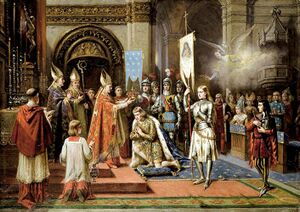
The Zeshen Kingdom continued to aid in the reconquest of Istroya from the remaining Odduniyad Caliphate and independent emirates. As the crusades came to a close however, the Catholic Church cracked down on Zeshen Kingdom and declared Lady Ava a heretic for wearing men's clothes and marrying a Muslim man. She risked being tried for blasphemy and excommunicated from the Catholic world unless she repented for what she had done. She repented for her wearing of men's clothing and agreed to resign from bearing arms. The Church forbid her from divorcing despite her husband being a Muslim man, but the Zeshen Kingdom was restructured into a grand duchy with the Christian Despot of the Iddryitine Despotate, Theodoric Abcis. Theodoric was crowned Archduke of Zeshinava and converted to Catholicism. Lady Ava became Grand Duchess Ava, and her husband Addas Al-Ahzmira becoming the Grand Duke. Though on roughly equal footing, it was expected that Ava would lead the state with Theodoric rather than Addas, with the Grand Duke title only serving as a technicality on Addas' name. The Iddryitine Despotate remained in the form of the Free Cities of Sydona which would stay under the exclusive control of Archduke Theodoric. This situation allowed Lady Ava to avoid persecution, excommunication, and potentially revolution at the hands of a population angered by her heretical actions, she still remained out of the good graces of much of the Catholic world and was largely forced to resign to the more traditional role of the female leaders of the Middle Ages.
Southern Trade Dominance
Following the collapse of the Caliphate in Sarpedon the new Grand Duchy of Zeshinava would assume the role of the trade hub of the south of the continent. While other major powers were mired by internal conflict through this period, the southern islands would maintain their place as trade hubs despite a new authority. While the Free Cities of Sydona shied away from interaction with the Muslim world, Zeshinava would lean into its position as a bridge between cultures and continents. This served to placate the subservient Muslim population of the officially Christian country and allowed conflict like the inquisitions through the rest of Sarpedon to be avoided, though not without disapproval from the Catholic Church. Though formerly at odds with the Caliphate, Audonian rulers would remain amicable with the Grand Duchy as to maintain a semblance of influence on the continent.
Early modern period
Dominance of the United Southern Working Class
Geography
-
Picturesque view of the Kronzciny waterfront.
-
The Tricameral Towers pictured in the background of the Kronzciny Historical District.
-
The twin peaks of Little Dia and Big Dia on the subtropical island of Diakrunum.
Zeshinava is located on the southeastern corner of Sarpedon.
Climate and environment
Is your country hot or cold?
Government and Politics
How is your country ruled or governed?
Executive
Since the 20th century, the Zeshen government has had what is known as an executive. The executive has absolute power over all of Zeshinava and is even able to edit some parts of the constitution, based on whether the constitutional amendment is listed as "Өtur taz Tikront" or "Above the Executive" in the constitution. Even amendments that are Өtur taz Tikront can be changed, but this can only be done if the Office of the Executive or the Executive themselves tries to pass the amendment through the difficult constitutional amendment process of Zeshinava. The executive almost exclusively abides by Zeshen law, despite legally not being required to.
The Executive of Zeshinava is chosen first and foremost at the request of the previous executive. Should someone who is not related to the Executive be names the heir to the throne it will be presented to them. However, should they decline or should an heir not be named, the Executive is chosen by presenting the title to the most closely related family member to the previous executive, provided they are younger than the former executive. Should no family member young enough to bear the title accept the position or be eligible, the title is presentes to the next most closely related family member. From siblings and children, to grandchildren, nieces, and nephews, and so forth.
Legislative
The tricameral Parliament of Zeshinava serves as the nation's legislature. The Parliament is divided into three different houses: The House of the Constituency, the House of the Administration, and the House of the Advisory. The House of the Constituency is the lower house of the Zeshen Parliament. This house provides each Zeshen electoral constituency a democratically elected representative in the Zeshen Parliament. Each representative is elected during the Zeshen federal election that takes place once every five years, or when an election is triggered in the legislature beforehand. The representatives are elected by each and every Zeshen citizen as defined by the constitution of the nation. Every citizen is given a single transferable vote that can be dedicated to one or more candidates in a ranked fashion per the preference of the voter.
Administrative regions
As a unitary republic, Zeshinava has administrative units whose non-partisan administrators are appointed by and responsible to the government in Kronzciny. Their overall mandate is extremely limited, and from a legal point of view the regions exist mainly to administer the national census. These regions are defined by a variety of cultural, environmental, geographic, and historical factors, among others. Beyond their limited authority, the primary social use of the regions of Zeshinava is to allow the citizens of each region a broader entity to associate with outside of their municipal unit or local area.
Zeshinava has five distinct regions, while in total there are seven regions per the inclusion of Lekronzatihl zaTaz Kronetihrs (previously known as Taz Ekrontiahnz) and Taz Өzihzhun. The Sydonia Islands represents an eighth region, whose administration exists on paper but whose existence is purely nominal due to Kiravian control of the islands.
Pohrank
The Pohrank region is primarily defined by the cultural differences between the people of Pohrank and the rest of the Zeshen populace. As early as the 5th century, the vast majority of the Pohranken tribes unified under a single banner and a single name. The tribal confederacy is most commonly referred to as the Siahr Vand after the warrior Zendru Vandyndhur. She was not the strongest warrior by any means, which stood out in one of the most brutal tribes of Zeshinava, but she created a philosophy that would pioneer the tribe to become magnitudes stronger than all than all the other tribes in Pohrank. Though still known as Zendrism in Zeshen, the philosophy would come to be known as pragmatic pacifism internationally.
Gabben
Suderavia
Noroeste
Politics
What political factions exist? Who has ruled predominantly?
Parties
Voting
As Zeshinava uses a single transferable vote system when electing new heads of government, there is a vast multitude of parties that vie for power in the country's elections. Prior to the 20th century, used a first-past-the-post voting system but this allowed the Grand Collective Will of the United Southern Working Class to take power by gaining the unanimous vote of the large Pohrank population. Though the communist party was barely able to take power, it had a slim majority over other parties. This was clearly not representative, so Palihnae Slavyihn worked with political think tanks like Andrick Chapeyev and Iayu Ѧtƨolѧv to develop a more representative and secure electoral system for Zeshinava. This new electoral system required political parties to really gain the support of the Zeshen people across the country in order to win an election. As a result, Zeshen politics have become extremely diverse ideologically, but Zeshen participation and engagement in politics is some of the highest in the world. The system as a whole however has created issues with the proportionality of the Zeshen House of the Constituency. Sizable portions of the lower house are often made up of constituency representatives who receive the majority of their votes through vote transfer, which allows candidates to take power is many do not directly support them, but prefer them as a reliable second or third option. This has meant that the Zeshen populace, while in theory being represented more accurately than under a full first-past-the-post electoral system, is not represented when the interests of their representatives in the House of the Constituency pursue initiatives the Zeshen populace did not really support, but rather supported more than another party.
Law
What kind of laws and legal system does your country employ?
Demographics
What kind of people live in your country?
Ethnicity
What ethnic groups make up your country?
Language
What language or languages do your country's people use? Are there any previously used languages no longer common? Are these languages native to your country or shared with another?
Religion
Religious affiliations in the XXX (20XX)
What do your country's people believe in religiously, if anything? How many groups are there?
Education
How many people in your country are educated?
Culture and Society
What do your people do, and what are they like?
Education
What is your country's education system like? How do the schools work? What do people think about education?
Attitudes and worldview
How do your country's people view life?
Kinship and family
How are families or kinship groups structured in your country?
Cuisine
What do your people eat?
Religion
What do your people believe? Rather than demographics, as above, think about how important religion is to your people and their view about their own and other religions. What is the relationship between the prevailing view and minority religious groups? Is it an official religion, and do any laws exist about free worship?
Arts and Literature
What type of art do your people make? Do they have a tradition of painted art, well-crafted television shows, or great music?
Sports
Does your country have any major sports leagues? What types of sports are played, both professionally and for fun by your country's people?"
Symbols
Are there any prominent symbols which are well known to represent your country?
Economy and Infrastructure
How does your country's economy work?
Industries and Sectors
What are the largest parts of your economy in terms of what they do?
Currency
What exchange systems are used within your country's economy?
Healthcare
How do people in your country procure medical care? How is it paid for?
Labor
How is labor organized within your country? Are there any social institutions or unions which deal with labor concerns?
Transportation
How do people in your country get around? Is there a major highway system as well as sea- and airports?
Energy
What type of energy keeps your nation going? Are you renewable or use fossil fuels, and if you are renewable, how recently did your country transition?
Technology
How advanced is your country? Is it an innovator, or does it largely import new developments?
Military
How large is your country's military? Is it large but poorly equipped or small and elite? Does your country have a martial tradition?

